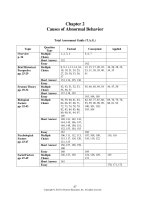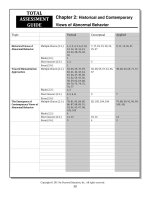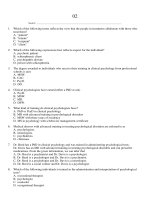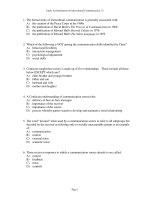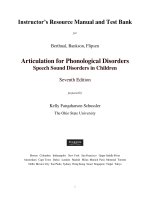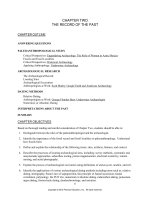Abnormal psychology 7th edition oltmanns test bank
Bạn đang xem bản rút gọn của tài liệu. Xem và tải ngay bản đầy đủ của tài liệu tại đây (397.65 KB, 57 trang )
Chapter 2
Causes of Abnormal Behavior
Total Assessment Guide (T.A.G.)
Topic
Overview
p. 24
Brief Historical
Perspective
pp. 25-29
Systems Theory
pp. 29-32
Biological
Factors
pp. 32-43
Question
Type
Multiple
Choice
Short Answer
Essay
Multiple
Choice
Short Answer
Essay
Multiple
Choice
Short Answer
Essay
Multiple
Choice
Short Answer
Psychological
Factors
pp. 43-47
Essay
Multiple
Choice
Short Answer
Social Factors
pp. 47-49
Essay
Multiple
Choice
Short Answer
Essay
Factual
1, 2, 3, 4
Conceptual
Applied
5, 6, 7
132
8, 9, 11, 13, 14, 16,
18, 19, 21, 24, 25,
27, 29, 30, 33, 36,
37
133, 134, 135, 136
42, 43, 51, 52, 53,
55, 56, 57
137, 138, 139
58, 59, 60, 61, 63,
64, 66, 67, 68, 71,
72, 73, 74, 78, 79,
82, 83, 84, 85, 86,
89, 90, 91, 94, 97,
105
140, 141, 142, 143,
144, 145, 146, 147,
148, 149, 150, 151,
152, 153, 154, 155
167
106, 111, 112, 113,
115, 117, 118, 120,
121, 123
156, 157, 158, 159,
160
168
126, 127, 130
162
12, 15, 17, 20, 22,
23, 31, 38, 39, 40,
41
10, 26, 28, 32,
34, 35
45, 46, 48, 49, 54
44, 47, 50
163, 164, 165
62, 65, 77, 87, 88,
93, 95, 96, 98, 99,
100, 101, 102,
103, 104
69, 70, 75, 76,
80, 81, 92
166
107, 108, 109,
110, 119, 122
114, 116
169
124, 128, 129,
131
125
161
170, 171, 172
47
Copyright © 2012 by Pearson Education, Inc. All rights reserved.
Chapter 2: Causes of Abnormal Behavior
Multiple Choice
2.1.1.
The etiology of a problem behavior is its
a.
b.
c.
d.
cause.
paradigm.
treatment.
classification.
Difficulty: 1
Question ID: 2.1.1
Page Reference: 24
Topic: Overview
Skill: Factual
Answer: a. cause.
2.1.2. Which term is used for a set of shared assumptions that includes both the substance of a theory
and beliefs about how scientists should collect data and test a theory?
a.
b.
c.
d.
etiology
paradigm
diagnosis
prognosis
Difficulty: 2
Question ID: 2.1.2
Page Reference: 24
Topic: Overview
Skill: Factual
Answer: b. paradigm
2.1.3.
Most forms of abnormal behavior are thought to be caused by
a.
b.
c.
d.
genetics.
learning.
a single cause.
multiple factors.
48
Copyright © 2012 by Pearson Education, Inc. All rights reserved.
Difficulty: 1
Question ID: 2.1.3
Page Reference: 24
Topic: Overview
Skill: Factual
Answer: d. multiple factors.
2.1.4.
What approach do the authors use when considering the etiology of various mental disorders?
a.
b.
c.
d.
systems
confluence
reductionism
biopsychosocial
Difficulty: 1
Question ID: 2.1.4
Page Reference: 24
Topic: Overview
Skill: Factual
Answer: d. biopsychosocial
2.1.5. A researcher described her approach to understanding mental disorders as biopsychosocial. When
you ask her to explain what she means, what is she likely to say?
a.
b.
c.
d.
Biological abnormalities give rise to psychological disturbances that have social consequences.
Biological, psychological, and social factors are just as likely to be the cause of these disorders.
The integration of biological, psychological, and social factors provides the most fruitful avenue
for discovering the cause of most mental disorders.
The search for etiologies is best accomplished by viewing the evidence through the lens provided
by one of the major paradigms.
Difficulty: 1
Question ID: 2.1.5
Page Reference: 24
Topic: Overview
Skill: Conceptual
Answer: c. The integration of biological, psychological, and social factors provides the most
fruitful avenue for discovering the cause of most mental disorders.
49
Copyright © 2012 by Pearson Education, Inc. All rights reserved.
2.1.6. A distinguished researcher reviewed the current findings on the etiology of mental disorders.
Which of the following is the best summary of the consensus of opinion?
a.
b.
c.
d.
Most mental disorders are the result of genetic abnormalities.
We do not currently know all of the specific causes of most mental disorders.
Unconscious factors have been overlooked as the root cause of mental disorders.
Environmental factors have been overlooked in the wake of recent findings on biological
etiologies.
Difficulty: 2
Question ID: 2.1.6
Page Reference: 24
Topic: Overview
Skill: Conceptual
Answer: b. We do not currently know all of the specific causes of most mental disorders.
2.1.7.
The case of Meghan B. in your text illustrates
a.
b.
c.
d.
many plausible alternative causes.
that disorders can often have a single cause.
the importance of genetic factors.
how objective tools can be used to pinpoint causation.
Difficulty: 1
Question ID: 2.1.7
Page Reference: 25
Topic: Overview
Skill: Conceptual
Answer: a. many plausible alternative causes.
2.1.8. The search for explanations of the etiology of abnormal behavior dates to ancient times. It was
not until the 19th and 20th centuries that three major advances occurred. Which of the following is NOT
one of these advances?
a.
b.
c.
d.
The discovery of the cause of general paresis.
The work of Sigmund Freud.
The development of the germ theory.
The development of academic psychology.
Difficulty: 1
Question ID: 2.1.8
Page Reference: 25
Topic: Brief Historical Perspective
Skill: Factual
Answer: c. The development of the germ theory.
50
Copyright © 2012 by Pearson Education, Inc. All rights reserved.
2.1.9. The discovery of the etiology of which disorder was an important scientific advance for the
biological paradigm?
a.
b.
c.
d.
general paresis
Alzheimer's disease
bipolar mood disorder
dissociative identity disorder
Difficulty: 1
Question ID: 2.1.9
Page Reference: 25
Topic: Brief Historical Perspective
Skill: Factual
Answer: a. general paresis
2.1.10. A physician at a hospital in the late 1800s has read about the disease called general paresis.
Which of the following patients is most likely to receive such a diagnosis?
a.
b.
c.
d.
Alice, whose symptoms include restlessness and agitation
Brenda, whose symptoms include insomnia and obsessiveness
Bob, whose symptoms include lack of appetite and thoughts of suicide
Al, whose symptoms include delusions of grandeur and progressive paralysis
Difficulty: 2
Question ID: 2.1.10
Page Reference: 25
Topic: Brief Historical Perspective
Skill: Applied
Answer: d. Al, whose symptoms include delusions of grandeur and progressive paralysis
2.1.11. The correct biological explanation for general paresis
a.
b.
c.
d.
was discovered very quickly.
is still a mystery to scientists.
will never be discovered.
was only discovered after more than 100 years of study.
Difficulty: 1
Question ID: 2.1.11
Page Reference: 25
Topic: Brief Historical Perspective
Skill: Factual
Answer: d. was only discovered after more than 100 years of study.
51
Copyright © 2012 by Pearson Education, Inc. All rights reserved.
2.1.12. Confirming a specific biological cause of general paresis was greatly aided by eventually
discovering that
a.
b.
c.
d.
all such patients had a history of syphilis.
most such patients developed syphilis later in life.
very few such patients had ever been treated with penicillin.
most such patients had lied about their sexual history.
Difficulty: 2
Question ID: 2.1.12
Page Reference: 25-26
Topic: Brief Historical Perspective
Skill: Conceptual
Answer: a. all such patients had a history of syphilis.
2.1.13. General paresis was virtually eliminated because
a.
b.
c.
d.
the patients died before they could have children.
antibiotics were developed to treat syphilis.
most older patients now develop Alzheimer's disease.
psychiatrists developed the tools to diagnose it.
Difficulty: 1
Question ID: 2.1.13
Page Reference: 26
Topic: Brief Historical Perspective
Skill: Factual
Answer: b. antibiotics were developed to treat syphilis.
2.1.14. You are reading a biography of Sigmund Freud and find that he was trained as a
a.
b.
c.
d.
neurologist.
psychiatrist.
clinical psychologist.
counseling psychologist.
Difficulty: 1
Question ID: 2.1.14
Page Reference: 26
Topic: Brief Historical Perspective
Skill: Factual
Answer: a. neurologist.
52
Copyright © 2012 by Pearson Education, Inc. All rights reserved.
2.1.15. Both Jean Charcot and Sigmund Freud focused on a disorder called hysteria. Which of the
following patients is most likely to have received this diagnosis from these two well-known clinicians?
a.
b.
c.
d.
Hazel, who experiences delusions
Amy, who screams during bouts of "night terrors"
Laura, whose "blindness" has no organic explanation
Zelda, who cannot sit still for more than 5 seconds
Difficulty: 1
Question ID: 2.1.15
Page Reference: 26
Topic: Brief Historical Perspective
Skill: Conceptual
Answer: c. Laura whose "blindness" has no organic explanation
2.1.16. According to Sigmund Freud, what are the three parts of the mind?
a.
b.
c.
d.
id, ego, superego
oral, anal, phallic
reality, pleasure, spiritual
conscious, preconscious, unconscious
Difficulty: 1
Question ID: 2.1.16
Page Reference: 26
Topic: Brief Historical Perspective
Skill: Factual
Answer: a. id, ego, superego
2.1.17. In psychoanalytic theory, sexual and aggressive drives are part of the
a.
b.
c.
d.
id.
ego.
superego.
conscience.
Difficulty: 2
Question ID: 2.1.17
Page Reference: 26
Topic: Brief Historical Perspective
Skill: Conceptual
Answer: a. id.
53
Copyright © 2012 by Pearson Education, Inc. All rights reserved.
2.1.18. According to Freudian theory, what part of the mind is roughly equivalent to the conscience?
a.
b.
c.
d.
id
ego
libido
superego
Difficulty: 1
Question ID: 2.1.18
Page Reference: 27
Topic: Brief Historical Perspective
Skill: Factual
Answer: d. superego
2.1.19. According to Freudian theory, the reality principle is the framework of operation for the
a.
b.
c.
d.
id.
ego.
superego.
conscience.
Difficulty: 1
Question ID: 2.1.19
Page Reference: 26
Topic: Brief Historical Perspective
Skill: Factual
Answer: b. ego.
2.1.20. According to Sigmund Freud, what is the purpose of defense mechanisms?
a.
b.
c.
d.
to reduce anxiety
to establish reality contact
to develop self‑ actualization
to reduce reliance on social support
Difficulty: 1
Question ID: 2.1.20
Page Reference: 27
Topic: Brief Historical Perspective
Skill: Conceptual
Answer: a. to reduce anxiety
54
Copyright © 2012 by Pearson Education, Inc. All rights reserved.
2.1.21. According to Sigmund Freud, how does a boy resolve forbidden sexual desire for his mother?
a.
b.
c.
d.
by becoming attracted to girls
by identifying with his father
by developing an Electra complex
by developing aggressive urges toward his mother
Difficulty: 1
Question ID: 2.1.21
Page Reference: 27
Topic: Brief Historical Perspective
Skill: Factual
Answer: b. by identifying with his father
2.1.22. When we are around someone we dislike intensely we often "bend over backward" to be nice to
this individual. Which defense mechanism is illustrated here?
a.
b.
c.
d.
denial
projection
sublimation
reaction formation
Difficulty: 1
Question ID: 2.1.22
Page Reference: 27
Topic: Brief Historical Perspective
Skill: Conceptual
Answer: d. reaction formation
2.1.23. You get a paper back and briefly feel angry at the low grade you received, but this feeling is
upsetting because you like the professor so much. You quickly turn your attention to other matters. Later
that day you pick a fight with your roommate because of the unfair manner in which the week's chores
were divided. This fight could be an example of a defense mechanism called
a.
b.
c.
d.
projection.
sublimation.
displacement.
rationalization.
Difficulty: 1
Question ID: 2.1.23
Page Reference: 27
Topic: Brief Historical Perspective
Skill: Conceptual
Answer: c. displacement.
55
Copyright © 2012 by Pearson Education, Inc. All rights reserved.
2.1.24. Who is credited with beginning the modern science of psychology at the University of Leipzig?
a.
b.
c.
d.
Ivan Pavlov
Wilhelm Wundt
B. F. Skinner
Sigmund Freud
Difficulty: 1
Question ID: 2.1.24
Page Reference: 27-28
Topic: Brief Historical Perspective
Skill: Factual
Answer: b. Wilhelm Wundt
2.1.25. The textbook suggests that Freud’s ideas were
a.
b.
c.
d.
scientifically valid.
metaphors.
of little value.
dangerous.
Difficulty: 1
Question ID: 2.1.25
Page Reference: 27
Topic: Brief Historical Perspective
Skill: Factual
Answer: b. metaphors.
2.1.26. The cognitive-behavioral paradigm views all of the following as the product of learning except
a.
b.
c.
d.
abnormal behavior.
normal behavior.
unconscious processes.
mental disorders.
Difficulty: 3
Question ID: 2.1.26
Page Reference: 27-28
Topic: Brief Historical Perspective
Skill: Applied
Answer: c. unconscious processes
56
Copyright © 2012 by Pearson Education, Inc. All rights reserved.
2.1.27. Ivan Pavlov rang a bell every time he fed meat powder to dogs. After repeated trials, the dogs
began to salivate when they heard the bell, even if there was no food in sight. According to Pavlov, the
dogs' salivation in the absence of food, following the ringing of the bell, is called the
a.
b.
c.
d.
conditioned stimulus.
conditioned response.
unconditioned stimulus.
unconditioned response.
Difficulty: 2
Question ID: 2.1.27
Page Reference: 28
Topic: Brief Historical Perspective
Skill: Factual
Answer: b. conditioned response.
2.1.28. Beth received a painful shock while turning on her television. Now she reacts with fear whenever
she sees a television. What is the television in this example?
a.
b.
c.
d.
neutral stimulus
reinforced stimulus
conditioned stimulus
unconditioned stimulus
Difficulty: 2
Question ID: 2.1.28
Page Reference: 28
Topic: Brief Historical Perspective
Skill: Applied
Answer: c. conditioned stimulus
2.1.29. According to Ivan Pavlov's ideas on classical conditioning, extinction occurs when a conditioned
stimulus is no longer presented along with
a.
b.
c.
d.
a negative reinforcer.
a conditioned response.
an unconditioned response.
an unconditioned stimulus.
Difficulty: 1
Question ID: 2.1.29
Page Reference: 28
Topic: Brief Historical Perspective
Skill: Factual
Answer: d. an unconditioned stimulus.
57
Copyright © 2012 by Pearson Education, Inc. All rights reserved.
2.1.30. What is the primary concept in operant conditioning?
a.
b.
c.
d.
a conditioned stimulus is neutral
conditioned response leads to extinction
behavior is determined by its consequences
negative reinforcement is the same as punishment
Difficulty: 2
Question ID: 2.1.30
Page Reference: 28
Topic: Brief Historical Perspective
Skill: Factual
Answer: c. behavior is determined by its consequences
2.1.31. According to the principles of operant conditioning, what happens when negative reinforcement
is applied?
a.
b.
c.
d.
behavior increases
behavior decreases
behavior is punished
behavior remains at the same level
Difficulty: 3
Question ID: 2.1.31
Page Reference: 28
Topic: Brief Historical Perspective
Skill: Conceptual
Answer: a. behavior increases
2.1.32. Your neighbors are playing loud music late at night and it annoys you. You ask them to turn
down the music and they do. The next time they play loud music, you call them even sooner. B. F.
Skinner would say this happens because
a.
b.
c.
d.
your assertiveness is like a punishment.
the noise was an unconditioned stimulus.
the decreased noise negatively reinforced your assertiveness.
the decreased noise positively reinforced your assertiveness.
Difficulty: 2
Question ID: 2.1.32
Page Reference: 28
Topic: Brief Historical Perspective
Skill: Applied
Answer: c. the decreased noise negatively reinforced your assertiveness.
58
Copyright © 2012 by Pearson Education, Inc. All rights reserved.
2.1.33. John B. Watson was best known for
a.
b.
c.
d.
founding humanism.
promoting behaviorism.
developing the theory of modeling.
developing the theory of operant conditioning.
Difficulty: 1
Question ID: 2.1.33
Page Reference: 28
Topic: Brief Historical Perspective
Skill: Factual
Answer: b. promoting behaviorism.
2.1.34. Mary and Jim took their two-year-old to the supermarket this past week. For more than an hour
all Little Jimmy did was yell and scream because in the past this would have obtained him an ice cream
cone. Jim managed to ignore him. Finally, Little Jimmy stopped yelling and screaming. What operant
conditioning concept is illustrated by this story?
a.
b.
c.
d.
shaping
extinction
punishment
token economy
Difficulty: 2
Question ID: 2.1.34
Page Reference: 28
Topic: Brief Historical Perspective
Skill: Applied
Answer: b. extinction
2.1.35. Though easily confused, negative reinforcement and punishment are quite different; with negative
reinforcement, behavior __________ when the aversive stimulus is ____________, and with punishment,
behavior __________ when the aversive stimulus is ____________.
a.
b.
c.
d.
increases; removed; increases; introduced
increases; removed; decreases; introduced
decreases; removed; increases; introduced
decreases; introduced; increases; removed
Difficulty: 2
Question ID: 2.1.35
Page Reference: 28
Topic: Brief Historical Perspective
Skill: Applied
59
Copyright © 2012 by Pearson Education, Inc. All rights reserved.
Answer: b. increases; removed; decreases; introduced
2.1.36. Watson made the very important assumption that all behavior is
a.
b.
c.
d.
under the control of free will.
inborn rather than learned.
the result of hidden desires and unconscious conflicts.
a result of learning.
Difficulty: 1
Question ID: 2.1.36
Page Reference: 28
Topic: Brief Historical Perspective
Skill: Factual
Answer: d. a result of learning.
2.1.37. Humanistic psychologists objected to the biological, psychoanalytic, and behavioral theories of
abnormal behavior because these other approaches assume that
a.
b.
c.
d.
free will exists.
behavior is a paradigm.
human nature is inherently good.
behavior is predictably determined.
Difficulty: 1
Question ID: 2.1.37
Page Reference: 28
Topic: Brief Historical Perspective
Skill: Factual
Answer: d. behavior is predictably determined.
2.1.38. Which paradigm views human nature as basically good, attributes abnormal behavior to
frustrations of society, and uses nondirective therapy to treat abnormal behavior?
a.
b.
c.
d.
biomedical
humanistic
psychoanalytic
cognitive behavioral
Difficulty: 1
Question ID: 2.1.38
Page Reference: 28
Topic: Brief Historical Perspective
Skill: Conceptual
Answer: b. humanistic
60
Copyright © 2012 by Pearson Education, Inc. All rights reserved.
2.1.39. Who is the historian and philosopher who has written about the nature of paradigms?
a.
b.
c.
d.
Sigmund Freud
Karl Byron
Thomas Kuhn
John Watson
Difficulty: 1
Question ID: 2.1.39
Page Reference: 28
Topic: Brief Historical Perspective
Skill: Conceptual
Answer: c. Thomas Kuhn.
2.1.40. What is the purpose of the enigma written by Lord Byron that was included in the text?
a.
b.
c.
d.
to show how writing can reveal one's unconscious memories
to provide an example of the integration of different etiologies
to reveal how paradigms can either help or hinder our search for answers
to demonstrate that a psychotic process can often be uncovered in the words of even greater
writers
Difficulty: 2
Question ID: 2.1.40
Page Reference: 29
Topic: Brief Historical Perspective
Skill: Conceptual
Answer: c. to reveal how paradigms can either help or hinder our search for answers
2.1.41. All four of the paradigms presented in your text make assumptions about the causes of abnormal
behavior that can be too
a.
b.
c.
d.
broad.
narrow.
untestable.
vague.
Difficulty: 1
Question ID: 2.1.41
Page Reference: 29
Topic: Brief Historical Perspective
Skill: Conceptual
Answer: b. narrow.
61
Copyright © 2012 by Pearson Education, Inc. All rights reserved.
2.1.42. Holism is the idea that
a.
b.
c.
d.
humans have free will.
behavior is determined.
human nature is basically good.
the whole is more than the sum of its parts.
Difficulty: 1
Question ID: 2.1.42
Page Reference: 29
Topic: Systems Theory
Skill: Factual
Answer: d. the whole is more than the sum of its parts.
2.1.43. The idea that ultimate explanations for abnormal behavior are found when problems are analyzed
in terms of their smallest components is known as
a.
b.
c.
d.
deduction.
paradigms.
determinism.
reductionism.
Difficulty: 3
Question ID: 2.1.43
Page Reference: 29
Topic: Systems Theory
Skill: Factual
Answer: d. reductionism.
2.1.44. Thinking of the different academic disciplines as representing different levels of analysis in trying
to understand the causes of abnormal behavior, systems theory asserts that
a.
b.
c.
d.
no single academic discipline has a corner on the truth.
the molar level is more helpful than the molecular level.
the molecular level is more helpful than the molar level.
only the molar level lends itself to rigorous research.
Difficulty: 1
Question ID: 2.1.44
Page Reference: 29
Topic: Systems Theory
Skill: Applied
Answer: a. no single academic discipline has a corner on the truth.
62
Copyright © 2012 by Pearson Education, Inc. All rights reserved.
2.1.45. A newspaper headline heralds a finding that an excess of a particular brain chemical is the cause
of a certain mental disorder. The article is not convincing to you. What potential flaw do you note in the
report?
a.
b.
c.
d.
The chemical change could be due to other variables.
Chemical changes cannot bring about changes in behavior.
The genetic code associated with the chemical has not been identified.
Such findings are very difficult to generalize to the entire population.
Difficulty: 1
Question ID: 2.1.45
Page Reference: 30
Topic: Systems Theory
Skill: Conceptual
Answer: a. The chemical change could be due to other variables.
2.1.46. Which of the following correlation coefficients indicates the strongest association between two
variables?
a.
b.
c.
d.
-0.74
-0.15
+0.26
+0.62
Difficulty: 2
Question ID: 2.1.46
Page Reference: 30
Topic: Systems Theory
Skill: Conceptual
Answer: a. -0.74
2.1.47. The correlation between scores on a measure of hostility and age at death is -.64. We could
conclude from this correlation coefficient that people
a.
b.
c.
d.
with high hostility scores tend to live longer.
who have low hostility scores tend to die younger.
who have high hostility scores tend to die younger.
who have low hostility scores die 64 percent sooner than those with high hostility scores.
Difficulty: 3
Question ID: 2.1.47
Page Reference: 30
Topic: Systems Theory
Skill: Applied
Answer: c. who have high hostility scores tend to die younger.
63
Copyright © 2012 by Pearson Education, Inc. All rights reserved.
2.1.48. Assume that variables X and Y are significantly correlated; the concept of reverse causality tells
us that
a.
b.
c.
d.
X causes Y but not the reverse.
Y causes X but not the reverse.
X might cause Y or Y might cause X.
X causes Y and Y causes X.
Difficulty: 3
Question ID: 2.1.48
Page Reference: 30
Topic: Systems Theory
Skill: Conceptual
Answer: c. X might cause Y or Y might cause X.
2.1.49. Assume that variables X and Y are significantly correlated; the third variable problem means that
a.
b.
c.
d.
the correlation could be explained by their joint relation with some other factor.
another variable must correlate with X but not Y.
another variable must correlate with Y but not X.
X causes Y and Y causes X.
Difficulty: 2
Question ID: 2.1.49
Page Reference: 30
Topic: Systems Theory
Skill: Conceptual
Answer: a. the correlation could be explained by their joint relation with some other factor.
2.1.50. A study has found a positive correlation between smoking cigarettes and schizophrenia. Which
is/are possible explanations for this finding?
a.
b.
c.
d.
A third variable could be causing both.
Some property of nicotine could be part of the cause of schizophrenia.
Something about the nature of schizophrenia could be a factor in the cause of smoking.
All of the above are possible explanations for this finding.
Difficulty: 3
Question ID: 2.1.50
Page Reference: 30
Topic: Systems Theory
Skill: Applied
Answer: d. All of the above are possible explanations for this finding.
64
Copyright © 2012 by Pearson Education, Inc. All rights reserved.
2.1.51. The principle of equifinality, or the concept of multiple pathways, means that
a.
b.
c.
d.
many risk factors might be involved in a disorder's etiology.
disorders must always be explained in terms of many different risk factors.
a diathesis must always be combined with some form of stress.
the same risk factors can produce many different disorders.
Difficulty: 2
Question ID: 2.1.51
Page Reference: 31
Topic: Systems Theory
Skill: Factual
Answer: a. many risk factors might be involved in a disorder's etiology.
2.1.52. Which of the following best illustrates reciprocal causality?
a.
b.
c.
d.
Parents influence their children and are also influenced by their own parents.
Parents influence their children both through heredity and through socialization.
Parents influence their children and children influence their parents.
Children are influenced both by their parents and by their peers.
Difficulty: 2
Question ID: 2.1.52
Page Reference: 32
Topic: Systems Theory
Skill: Factual
Answer: c. Parents influence their children and children influence their parents.
2.1.53. What is a diathesis?
a.
b.
c.
d.
a form of stress
a predisposition
a biological cause of mental illness
an observable symptom of mental illness
Difficulty: 1
Question ID: 2.1.53
Page Reference: 31
Topic: Systems Theory
Skill: Factual
Answer: b. a predisposition
65
Copyright © 2012 by Pearson Education, Inc. All rights reserved.
2.1.54. Some researchers view alcoholism as the result of a genetic predisposition to be addicted to
alcohol plus life experiences that drive a person to drink more and more. This type of analysis is an
example of
a.
b.
c.
d.
circular thinking.
biological etiology.
the diathesis-stress model.
the nature-nurture controversy.
Difficulty: 2
Question ID: 2.1.54
Page Reference: 31
Topic: Systems Theory
Skill: Conceptual
Answer: c. the diathesis-stress model.
2.1.55. Developmental psychopathology is a new approach to abnormal psychology that emphasizes the
importance of analyzing behavior in terms of
a.
b.
c.
d.
cybernetics.
early childhood trauma.
learned patterns that are ingrained over time.
comparisons of individual behavior to age-based norms.
Difficulty: 2
Question ID: 2.1.55
Page Reference: 32
Topic: Systems Theory
Skill: Factual
Answer: d. comparisons of individual behavior to age-based norms.
2.1.56. What term is used to describe the pattern of behavior that is apparent before a disorder develops?
a.
b.
c.
d.
premorbid history
prognosis
homeostasis
developmental history
Difficulty: 2
Question ID: 2.1.56
Page Reference: 32
Topic: Systems Theory
Skill: Factual
Answer: a. premorbid history
66
Copyright © 2012 by Pearson Education, Inc. All rights reserved.
2.1.57. You are watching a movie about a mental hospital. In one scene two mental health professionals
are talking about a patient. One of them asks about the patient's prognosis. The response to this question
will deal with the patient's
a.
b.
c.
d.
diagnosis.
predicted course.
premorbid history.
developmental norm.
Difficulty: 1
Question ID: 2.1.57
Page Reference: 32
Topic: Systems Theory
Skill: Factual
Answer: b. predicted course.
2.1.58. Neuroanatomy focuses on brain _________ while neurophysiology focuses on brain __________.
a.
b.
c.
d.
functions; structures
structures; functions
dendrites; axons
axons; dendrites
Difficulty: 1
Question ID: 2.1.58
Page Reference: 32
Topic: Biological Factors
Skill: Factual
Answer: b. structures; functions
2.1.59. Which of the following is NOT a part of a neuron?
a.
b.
c.
d.
dendrite
nerve
axon
soma
Difficulty: 1
Question ID: 2.1.59
Page Reference: 32
Topic: Biological Factors
Skill: Factual
Answer: b. nerve
67
Copyright © 2012 by Pearson Education, Inc. All rights reserved.
2.1.60. A synapse is a
a.
b.
c.
d.
cell body.
nerve cell.
chemical substance in the brain.
fluid-filled gap between neurons.
Difficulty: 2
Question ID: 2.1.60
Page Reference: 32
Topic: Biological Factors
Skill: Factual
Answer: d. fluid-filled gap between neurons.
2.1.61. How is information transmitted between nerve cells?
a.
b.
c.
d.
by release of neurotransmitters at the synapse
by release of neurotransmitters along the axon
by changes in electrical potential along the axon
by changes in electrical potential in the synapse
Difficulty: 1
Question ID: 2.1.61
Page Reference: 32-33
Topic: Biological Factors
Skill: Factual
Answer: a. by release of neurotransmitters at the synapse
2.1.62. A report of research on physiological psychology contains a description of a substance that can
influence communication among neurons and can act some distance from where the substance was
released. What is the topic of this report?
a.
b.
c.
d.
axons
humors
neuromodulators
neurotransmitters
Difficulty: 2
Question ID: 2.1.62
Page Reference: 33
Topic: Biological Factors
Skill: Conceptual
Answer: c. neuromodulators
68
Copyright © 2012 by Pearson Education, Inc. All rights reserved.
2.1.63. What is the process by which some neurotransmitters in the synapse return to the axon terminals
of the neuron that released them?
a.
b.
c.
d.
reuptake
regeneration
neuromodulation
neuroregeneration
Difficulty: 1
Question ID: 2.1.63
Page Reference: 33
Topic: Biological Factors
Skill: Factual
Answer: a. reuptake
2.1.64. Chemicals that may be released from neurons or from endocrine glands and that affect the
functioning of neurotransmitters are known as
a.
b.
c.
d.
adrenotransmitters.
neuromodulators.
reuptake inhibitors.
reuptake facilitators.
Difficulty: 2
Question ID: 2.1.64
Page Reference: 33
Topic: Biological Factors
Skill: Factual
Answer: b. neuromodulators.
2.1.65. All of the following have been suggested as a way that neurotransmitters could play a role in
abnormal behavior except
a.
b.
c.
d.
an oversupply of a certain neurotransmitter.
an undersupply of a neurotransmitter.
faulty genes that misfold the proteins that make up a given neurotransmitter.
a disturbance in the reuptake mechanism for a given neurotransmitter.
Difficulty: 1
Question ID: 2.1.65
Page Reference: 33
Topic: Biological Factors
Skill: Conceptual
Answer: c. faulty genes that misfold the proteins that make up a given neurotransmitter.
69
Copyright © 2012 by Pearson Education, Inc. All rights reserved.
2.1.66. Dualism refers to the out-of-date idea that
a.
b.
c.
d.
mind and body are separate.
the whole is more than the sum of its parts.
the brain is made up of structures and functions.
behavior is influenced by free will and determinism.
Difficulty: 2
Question ID: 2.1.66
Page Reference: 34
Topic: Biological Factors
Skill: Factual
Answer: a. mind and body are separate.
2.1.67. Which of the following neurotransmitters was first implicated in the development of
schizophrenia?
a.
b.
c.
d.
GABA
dopamine
serotonin
norepinephrine
Difficulty: 1
Question ID: 2.1.67
Page Reference: 33
Topic: Biological Factors
Skill: Factual
Answer: b. dopamine
2.1.68. Basic bodily functions such as heart rate, blood pressure, and respiration are regulated by which
region of the brain?
a.
b.
c.
d.
pons
medulla
midbrain
corpus callosum
Difficulty: 1
Question ID: 2.1.68
Page Reference: 34
Topic: Biological Factors
Skill: Factual
Answer: b. medulla
70
Copyright © 2012 by Pearson Education, Inc. All rights reserved.
2.1.69. A police officer pulls over a driver suspected of driving under the influence of alcohol. The driver
is asked to exit the car and walk a straight line. This test is designed to detect the effects of alcohol on the
a.
b.
c.
d.
cerebellum.
hypothalamus.
temporal lobe.
limbic system.
Difficulty: 1
Question ID: 2.1.69
Page Reference: 34
Topic: Biological Factors
Skill: Applied
Answer: a. cerebellum.
2.1.70. Evidence that effective treatments for depression inhibit the reuptake of a neurotransmitter links a
depletion of that neurotransmitter to mood disorders. That neurotransmitter is
a.
b.
c.
d.
dopamine.
GABA.
serotonin.
Prozac.
Difficulty: 2
Question ID: 2.1.70
Page Reference: 33
Topic: Biological Factors
Skill: Applied
Answer: c. serotonin
2.1.71. The ________ is involved with some motor activities associated with fighting and sexual
behavior.
a.
b.
c.
d.
midbrain
forebrain
hindbrain
corpus callosum
Difficulty: 1
Question ID: 2.1.71
Page Reference: 34
Topic: Biological Factors
Skill: Factual
Answer: a. midbrain
71
Copyright © 2012 by Pearson Education, Inc. All rights reserved.
